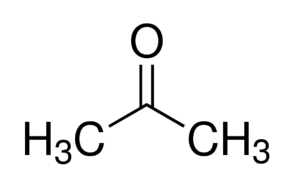Class 12 Exam > Class 12 Questions > Acetone is isomeric to:a)n-propyl alcoholb)pr...
Start Learning for Free
Acetone is isomeric to:
- a)n-propyl alcohol
- b)propanal
- c)ethyl methyl ether
- d)isopropyl alcohol
Correct answer is option 'B'. Can you explain this answer?
Verified Answer
Acetone is isomeric to:a)n-propyl alcoholb)propanalc)ethyl methyl ethe...
Acetone (CH3COCH3) and Propanal (CH3CH2CHO) are functional isomers.
- Acetone:

- Propanal:

Most Upvoted Answer
Acetone is isomeric to:a)n-propyl alcoholb)propanalc)ethyl methyl ethe...
Functional isomerism is a type of structural isomerism in which compounds have the same molecular formula but different functional groups. In the case of acetone (CH3COCH3) and propanal (CH3CH2CHO), they both have the molecular formula C3H6O but differ in their functional groups.
Acetone, also known as propanone, is a ketone with the functional group being a carbonyl group (C=O) bonded to two alkyl groups (methyl groups in this case). On the other hand, propanal, also known as propionaldehyde, is an aldehyde with the functional group being a carbonyl group bonded to one alkyl group (ethyl group in this case) and one hydrogen atom.
To better understand why acetone and propanal are functional isomers, let's break down their structural formulas:
Acetone:
CH3COCH3
- The carbonyl group (C=O) is located in the middle of the molecule.
- It is surrounded by two methyl (CH3) groups.
Propanal:
CH3CH2CHO
- The carbonyl group (C=O) is located at the end of the molecule.
- It is surrounded by one ethyl (CH3CH2) group and one hydrogen atom.
As we can see, despite having the same molecular formula, acetone and propanal differ in the arrangement of their functional groups. Acetone has a carbonyl group surrounded by two alkyl groups, while propanal has a carbonyl group surrounded by one alkyl group and one hydrogen atom. This difference in functional groups results in different chemical properties and reactivities for the two compounds.
In conclusion, acetone and propanal are functional isomers because they have the same molecular formula (C3H6O) but different functional groups. Acetone is a ketone, while propanal is an aldehyde, and their structural formulas reflect the difference in the arrangement of their functional groups.
Acetone, also known as propanone, is a ketone with the functional group being a carbonyl group (C=O) bonded to two alkyl groups (methyl groups in this case). On the other hand, propanal, also known as propionaldehyde, is an aldehyde with the functional group being a carbonyl group bonded to one alkyl group (ethyl group in this case) and one hydrogen atom.
To better understand why acetone and propanal are functional isomers, let's break down their structural formulas:
Acetone:
CH3COCH3
- The carbonyl group (C=O) is located in the middle of the molecule.
- It is surrounded by two methyl (CH3) groups.
Propanal:
CH3CH2CHO
- The carbonyl group (C=O) is located at the end of the molecule.
- It is surrounded by one ethyl (CH3CH2) group and one hydrogen atom.
As we can see, despite having the same molecular formula, acetone and propanal differ in the arrangement of their functional groups. Acetone has a carbonyl group surrounded by two alkyl groups, while propanal has a carbonyl group surrounded by one alkyl group and one hydrogen atom. This difference in functional groups results in different chemical properties and reactivities for the two compounds.
In conclusion, acetone and propanal are functional isomers because they have the same molecular formula (C3H6O) but different functional groups. Acetone is a ketone, while propanal is an aldehyde, and their structural formulas reflect the difference in the arrangement of their functional groups.
Free Test
FREE
| Start Free Test |
Community Answer
Acetone is isomeric to:a)n-propyl alcoholb)propanalc)ethyl methyl ethe...
Answer is B because both compound has same general form like CnH2nO here n = 3

|
Explore Courses for Class 12 exam
|

|
Question Description
Acetone is isomeric to:a)n-propyl alcoholb)propanalc)ethyl methyl etherd)isopropyl alcoholCorrect answer is option 'B'. Can you explain this answer? for Class 12 2025 is part of Class 12 preparation. The Question and answers have been prepared according to the Class 12 exam syllabus. Information about Acetone is isomeric to:a)n-propyl alcoholb)propanalc)ethyl methyl etherd)isopropyl alcoholCorrect answer is option 'B'. Can you explain this answer? covers all topics & solutions for Class 12 2025 Exam. Find important definitions, questions, meanings, examples, exercises and tests below for Acetone is isomeric to:a)n-propyl alcoholb)propanalc)ethyl methyl etherd)isopropyl alcoholCorrect answer is option 'B'. Can you explain this answer?.
Acetone is isomeric to:a)n-propyl alcoholb)propanalc)ethyl methyl etherd)isopropyl alcoholCorrect answer is option 'B'. Can you explain this answer? for Class 12 2025 is part of Class 12 preparation. The Question and answers have been prepared according to the Class 12 exam syllabus. Information about Acetone is isomeric to:a)n-propyl alcoholb)propanalc)ethyl methyl etherd)isopropyl alcoholCorrect answer is option 'B'. Can you explain this answer? covers all topics & solutions for Class 12 2025 Exam. Find important definitions, questions, meanings, examples, exercises and tests below for Acetone is isomeric to:a)n-propyl alcoholb)propanalc)ethyl methyl etherd)isopropyl alcoholCorrect answer is option 'B'. Can you explain this answer?.
Solutions for Acetone is isomeric to:a)n-propyl alcoholb)propanalc)ethyl methyl etherd)isopropyl alcoholCorrect answer is option 'B'. Can you explain this answer? in English & in Hindi are available as part of our courses for Class 12.
Download more important topics, notes, lectures and mock test series for Class 12 Exam by signing up for free.
Here you can find the meaning of Acetone is isomeric to:a)n-propyl alcoholb)propanalc)ethyl methyl etherd)isopropyl alcoholCorrect answer is option 'B'. Can you explain this answer? defined & explained in the simplest way possible. Besides giving the explanation of
Acetone is isomeric to:a)n-propyl alcoholb)propanalc)ethyl methyl etherd)isopropyl alcoholCorrect answer is option 'B'. Can you explain this answer?, a detailed solution for Acetone is isomeric to:a)n-propyl alcoholb)propanalc)ethyl methyl etherd)isopropyl alcoholCorrect answer is option 'B'. Can you explain this answer? has been provided alongside types of Acetone is isomeric to:a)n-propyl alcoholb)propanalc)ethyl methyl etherd)isopropyl alcoholCorrect answer is option 'B'. Can you explain this answer? theory, EduRev gives you an
ample number of questions to practice Acetone is isomeric to:a)n-propyl alcoholb)propanalc)ethyl methyl etherd)isopropyl alcoholCorrect answer is option 'B'. Can you explain this answer? tests, examples and also practice Class 12 tests.

|
Explore Courses for Class 12 exam
|

|
Signup for Free!
Signup to see your scores go up within 7 days! Learn & Practice with 1000+ FREE Notes, Videos & Tests.



















